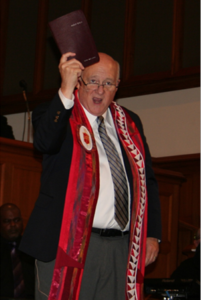In A Mirror Dimly-Response to a Series by Bishop Michael Lowry-Part 4

United Methodist Bishop, J. Michael Lowry of the Central Texas Conference, recently addressed a gathering of the United Methodist Scholars for Christian Orthodoxy Conference at Armstrong Chapel United Methodist Church in Cincinnati, Ohio. He has put his address, “In a Mirror Dimly”: The Future of the United Methodist Church”© on his website as a four-part posting.
Bishop Lowry seems to argue that the Methodist Church should (or at least, likely will) split over the issue of the inclusion of LGBT people. As you might guess, given that he’s speaking to people who claim to be “orthodox,” that he is, as southerners might say, “agin it.” And of course, that would mean that, while I don’t disagree a split may happen, I don’t agree with his position on the topic at hand.
This is a short conclusion to Bishop Lowry’s series. He claims, “signs of new life all around.” This is his clinging to the belief that it will be the orthodox church (his definition of orthodoxy) that survives and thrives, all evidence to the contrary.
Bishop Lowry provides a lengthy quote here from Ross Douthat’s book “Bad Religion,” meant to show that there have been five significant moments in Western history where it seemed the church was doomed to perish or at least fade to the margins. But according to Douthat, citing G.K. Chesterston, each of these periods was followed, “by an era of renewal, in which forces threatening the faith either receded or were discredited and Christianity itself revived.”
Here again, I find common ground with the position of the Bishop. the Church certainly has survived over history, and experienced cyclical periods of growth, sometimes by force of arms and/or magisterial mandate. But in each case, the “orthodoxies” of the periods of decline were challenged and changed, and that is when the Churches experienced their periods of renewal. A micro-version is seen in the Church in North America. The orthodoxy of the Church changed from supporting slavery, prohibiting divorce and re-marriage, allowing the ordination of women, and the list, over 2,000 years, goes on.
Where Bishop Lowry’s thesis fails is his claim to “orthodoxy.” He quotes McGrarth again: “The pursuit of orthodoxy is essentially the quest for Christian authenticity.” An “orthodox” Christian of today would be anathema to the early Christians. As I’ve noted throughout, Lowry’s claim to orthodoxy has nothing to do with maintaining biblical law and tradition in its strictest sense. His definition of orthodoxy is merely maintaining the current status quo of suppressing certain groups of people he does not like, and continuing discrimination against that group.
Even in this article, he makes it clear he would dispense with certain aspects of doctrine which would certainly be considered orthodox. But he disagrees with those aspects of Methodism, so we change those and keep the hateful aspects he so cherishes.
So in summary, there was no original thinking in Bishop Lowry’s treatise. It is the tired old rehash of claiming that orthodoxy is all about hating LGBT people, and the only real Christians are those who believe exactly as he does, and (again, all evidence to the contrary) his version of orthodoxy will prevail.
And despite Lowry’s attempt to claim a historical foundation for his optimism, the dirty little secret is that the very history he cites is hardly on his side.
